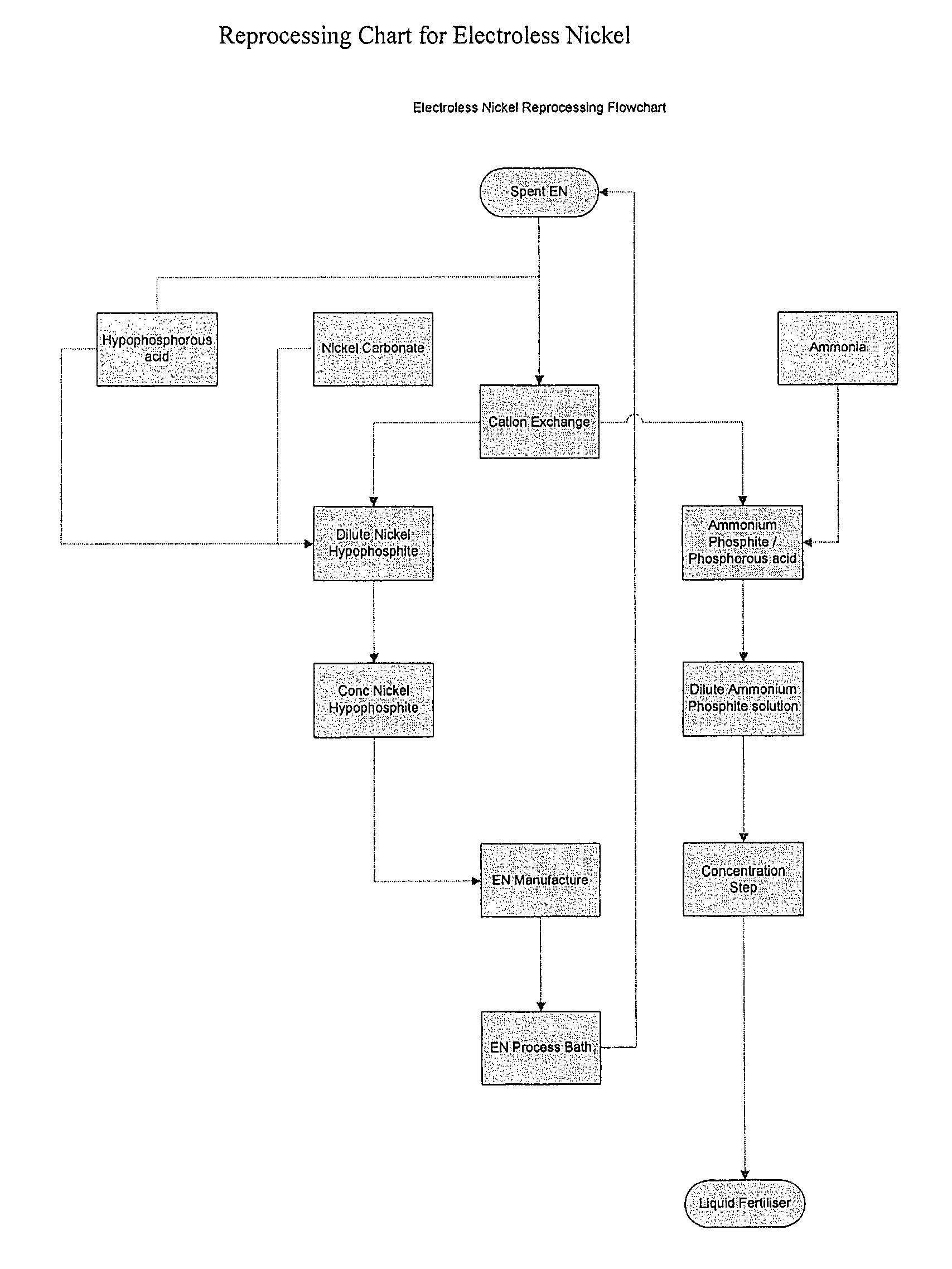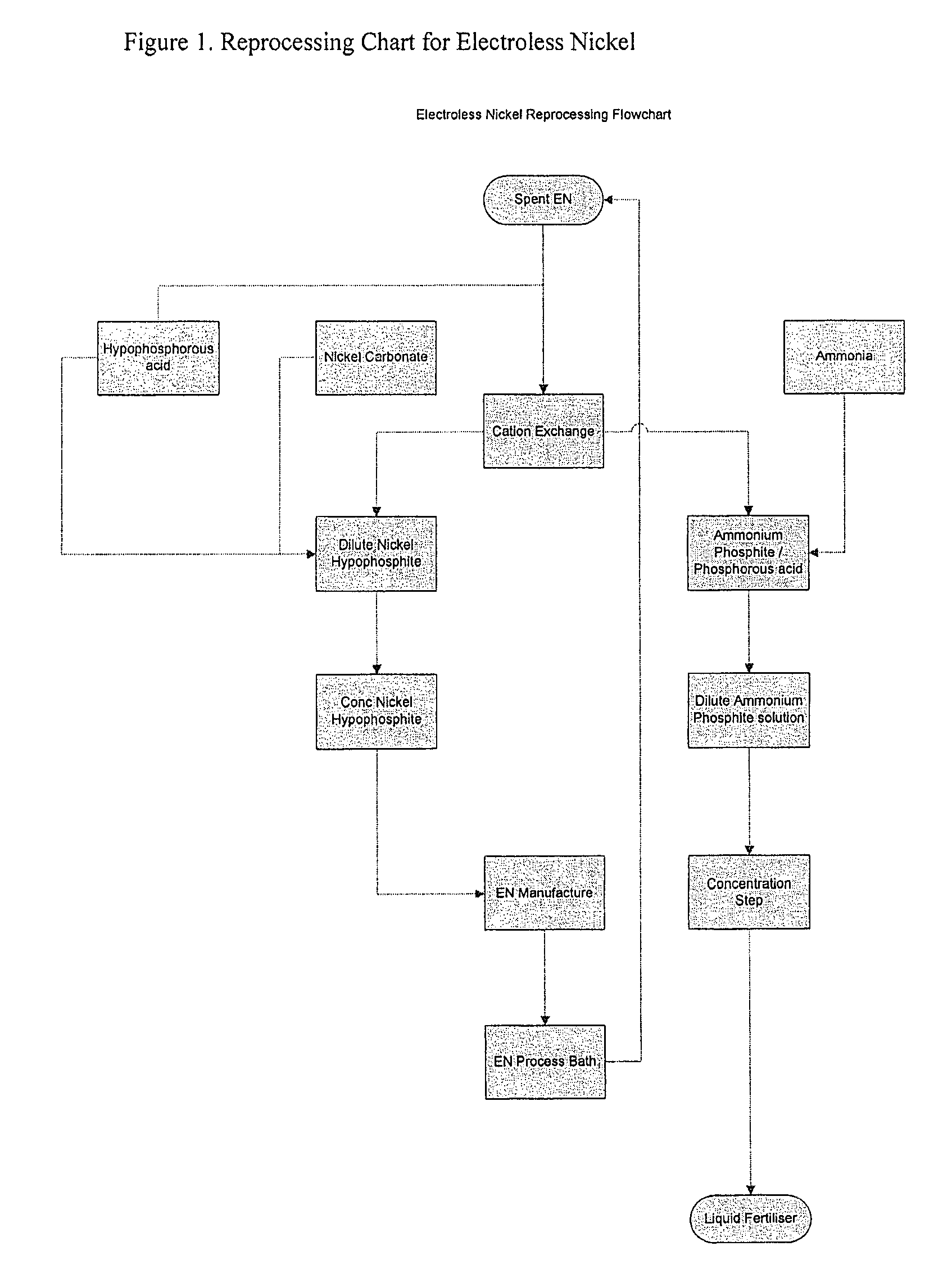Method of recycling electroless nickel waste
a technology of electroless nickel and waste, applied in the direction of liquid/solution decomposition chemical coating, process efficiency improvement, coating, etc., can solve the problems of generating significant waste, unable to address the above methods, and the rate of metal deposition becoming too slow for commercial operation, so as to avoid production
- Summary
- Abstract
- Description
- Claims
- Application Information
AI Technical Summary
Benefits of technology
Problems solved by technology
Method used
Image
Examples
example 1
[0035]An electroless nickel solution was made up according to the following formulation:
[0036]
Nickel metal 6 g / l (added as nickel carbonate)Hypophosphorous acid 27 g / lAcetic acid 18 g / lLactic acid 26 g / lLead 2 ppmAmmonium Iodate200 ppmAmmonia solutionSufficient to adjust the pH to 4.8
[0037]The bath was operated at 88-90° C. Nickel was plated from the bath and concentrations of hypophosphite and nickel were maintained by adding ammonium hypophosphite and nickel hypophosphite to the bath. The pH of the bath was maintained by the addition of the ammonia solution. Lead and iodate concentrations were maintained by adding lead as lead acetate and ammonium iodate.
[0038]The bath was operated in this manner until 4 metal “turnovers” had been achieved. At this point, an analysis of the bath demonstrated that the bath contained the following composition:
[0039]
Nickel metal 6 g / lHypophosphite ion25 g / lAcetic acid20 g / lLactic acid28 g / lAmmonium Phosphite180 g / l
[0040]The “spent” solution was then...
example 2
[0048]The bath described in example 1 was operated at 88-90° C. Nickel was plated from the bath and concentrations of hypophosphite and nickel were maintained by adding ammonium hypophosphite and nickel hypophosphite. The pH of the bath was maintained by adding potassium carbonate solution. Lead and iodate concentrations were maintained by adding lead as lead acetate and ammonium iodate.
[0049]The bath was operated in this manner until 4 metal “turnovers” had been achieved. At this point, the analysis of the bath gave the following composition:
[0050]
Nickel metal 6 g / lHypophosphite ion25 g / lAcetic acid20 g / lLactic acid28 g / lPhosphite ions125 g / l Potassium ions120 g / l Ammonium ions25 g / l
[0051]Nickel ions were then removed from the bath using the method described in example 1, but instead of using the acid form of the resin, the potassium form of the resin was first generated by treating the acid form of the resin with a dilute potassium hydroxide solution. This was to prevent subsequen...
PUM
| Property | Measurement | Unit |
|---|---|---|
| concentration | aaaaa | aaaaa |
| concentration | aaaaa | aaaaa |
| temperature | aaaaa | aaaaa |
Abstract
Description
Claims
Application Information
 Login to View More
Login to View More - R&D
- Intellectual Property
- Life Sciences
- Materials
- Tech Scout
- Unparalleled Data Quality
- Higher Quality Content
- 60% Fewer Hallucinations
Browse by: Latest US Patents, China's latest patents, Technical Efficacy Thesaurus, Application Domain, Technology Topic, Popular Technical Reports.
© 2025 PatSnap. All rights reserved.Legal|Privacy policy|Modern Slavery Act Transparency Statement|Sitemap|About US| Contact US: help@patsnap.com


